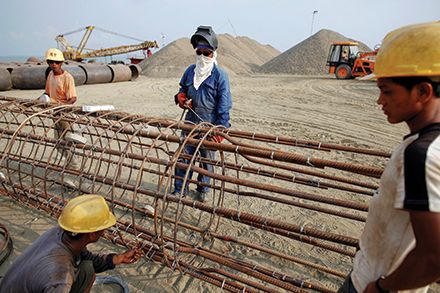Sweeping regulatory changes are giving banks new powers to enforce recoveries on non-performing assets, breaking with a culture of routine deferments and debtor unaccountability.
India’s debt restructuring process was once summed up by the alternative nickname for corporate debt restructuring (CDR) – kicking the “can down the road”.
In the absence of a timely, clear system to restructure debt and enforce recoveries, many Indian creditors were happy to simply roll over maturities and hope their debtors’ fortunes would recover, but a raft of reforms is changing that.
As of June 2015, the World Bank estimated that the recovery rate on assets after going through the insolvency process was around 26% in India and it took 4.3 years on average to resolve cases, longer than in Bangladesh, the Philippines or Sri Lanka, and twice as long as in China.
India has asset reconstruction companies, or bad banks, tasked with buying and rehabilitating non-performing assets, but rating agency Crisil estimates that even these specialists achieve a recovery rate of only 36%, with an average resolution taking five years.
“India is moving towards a very effective framework where debt issues can be identified and resolved quickly. It’s giving much more confidence to international investors that these issues can be resolved”
India’s new Bankruptcy and Insolvency code, passed in Parliament’s lower house in May this year, proposes a much quicker timeline of 180 days for resolution, with the option to increase that by 90 days. The code consolidates several laws that allowed borrowers to drag claims through the courts for years and file multiple appeals.
“India is moving towards a very effective framework where debt issues can be identified and resolved quickly,” said Dinkar Venkatasubramanian, partner, restructuring and turnaround, at EY in India. “It’s giving much more confidence to international investors that these issues can be resolved and they don’t have to deal with stakeholders and issuers who will hold them to ransom.”
Venkatasubramanian said special situation and distressed funds had committed US$8bn-$10bn to India in the past six months or so.
Equally important was the Reserve Bank of India’s move last year to force banks to recognise bad loans. Previously, many banks had been content to repeatedly extend maturities on debt when they knew there was little chance of being repaid in full.
“This has brought them to their senses,” said Rajiv Kochhar, founder and CEO of Avista Advisory, an affiliate of investment bank Houlihan Lokey. “It has made India more transparent and improved credit management. A lot of companies are selling off assets to pay down debt, so that’s very positive. Two or three years ago, that was not even thought of.”
This should also encourage banks to change their approach to lending in the first place.
“The shift in mindset from collateral-based lending to cashflow lending will probably come,” said Graham Martin, partner and Singapore-based head of restructuring at KPMG. “It might change the mindsets of borrowers, and put them in the position where they are more concerned about their cashflows and their ability to service debt.”
Positive for capital markets
Increased confidence in recovery prospects could also benefit the capital markets. India’s onshore bond market is dominated by high-grade issues, since investors were less keen on being unsecured creditors of weaker companies, knowing they would face an uphill struggle to recover anything in the event of a default.
“We believe the code will instil far greater financial discipline among borrowers,” wrote Pawan Agrawal, chief analytical officer at Crisil. “It can also potentially kindle investor interest in lower-rated (below AA category) corporate bonds, which will help in deepening the market.”
India has also amended the process by which bank and ARC creditors can convert debt to equity in struggling companies.
The new Scheme for Sustainable Structuring of Stressed Assets (S4A) allows these creditors to convert part of their claims into shares of borrowers with outstanding debts of more than Rs5bn (US$74m) and revenue-generating projects. Borrowers must maintain at least 50% of their outstanding debt, which needs to be sustainable, at the same terms and the remainder can be converted into equity or equity-linked instruments.
Company founders and major shareholders had previously resisted giving up control, while creditors had tried to avoid making large provisions, but now the existing management can stay in position and banks do not need to write down the entire debt.
“S4A is a bit of departure from the ‘creditor in control’ stance taken by the RBI in recent times; control remains with the business owners as long as 50% of their debt is sustainable in S4A,” said EY’s Venkatasubramanian. “S4A has found limited applicability in stressed businesses as it prescribes a short-term cash-flow visibility and does not allow change in repayment terms. Even if these are addressed, the lack of emphasis on a comprehensive turnaround could possibly result in the problem being postponed.”
There is still the chance that the S4A scheme could evolve.
“Several banks have petitioned the RBI for tweaking of features of the scheme to allow certain timelines in terms of repayments schedule to be extended, and change of norms to allow cases with more than 50% component of sustainable debt to be considered under the scheme,” said Uday Bhansali, president, financial advisory, at Deloitte in India, adding that it might in future be extended to other classes of creditors.
“While the S4A tool could be potentially very helpful, its efficacy would be as an adjunct to other means of recovery,” he said. “As we have seen recently with a few large Indian groups which have had huge exposures, M&A as a means to transfer assets to stronger hands is possibly the most effective route to lenders recovering a portion of their outstandings.”
Essar Group’s Rs850bn (US$12.7bn) sale of its holdings in Essar Oil and Vadinar port in mid-October to foreign investors could be a sign that India’s business leaders are now putting more priority on managing debt, rather than negotiating extensions.
To see the digital version of this report, please click here
To purchase printed copies or a PDF of this report, please email gloria.balbastro@tr.com



